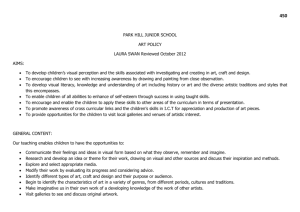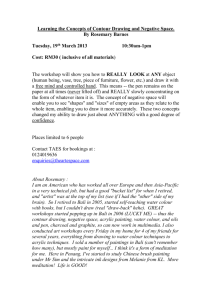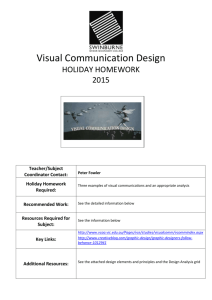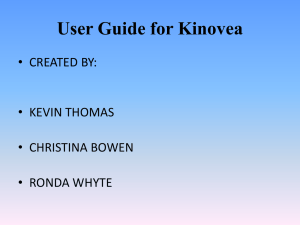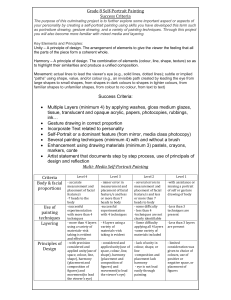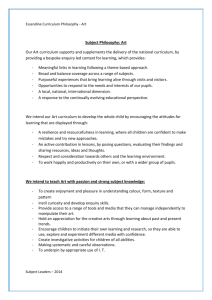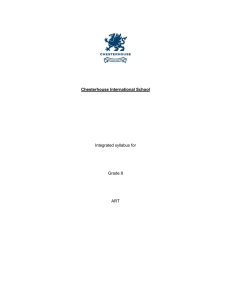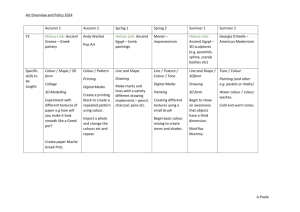Year 7 Art Assessment Table 2014-15
advertisement
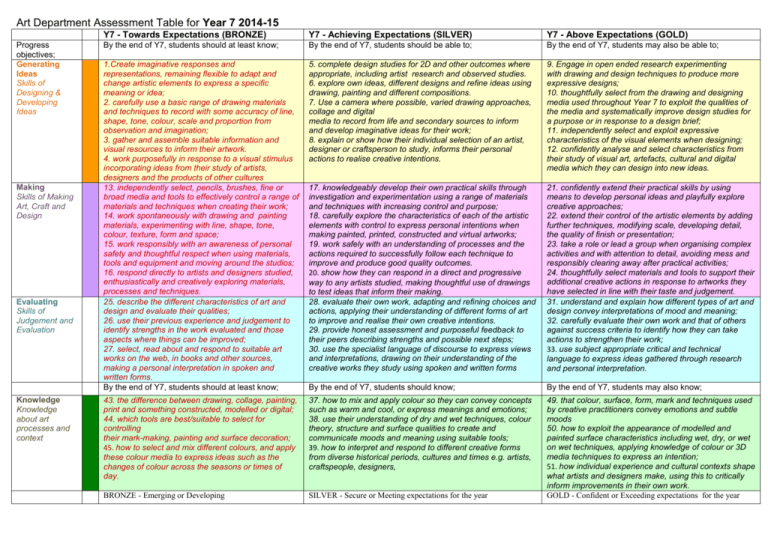
Art Department Assessment Table for Year 7 2014-15 Progress objectives; Generating Ideas Skills of Designing & Developing Ideas Making Skills of Making Art, Craft and Design Evaluating Skills of Judgement and Evaluation Knowledge Knowledge about art processes and context Y7 - Towards Expectations (BRONZE) Y7 - Achieving Expectations (SILVER) Y7 - Above Expectations (GOLD) By the end of Y7, students should at least know; By the end of Y7, students should be able to; By the end of Y7, students may also be able to; 1.Create imaginative responses and representations, remaining flexible to adapt and change artistic elements to express a specific meaning or idea; 2. carefully use a basic range of drawing materials and techniques to record with some accuracy of line, shape, tone, colour, scale and proportion from observation and imagination; 3. gather and assemble suitable information and visual resources to inform their artwork. 4. work purposefully in response to a visual stimulus incorporating ideas from their study of artists, designers and the products of other cultures 13. independently select, pencils, brushes, fine or broad media and tools to effectively control a range of materials and techniques when creating their work; 14. work spontaneously with drawing and painting materials, experimenting with line, shape, tone, colour, texture, form and space; 15. work responsibly with an awareness of personal safety and thoughtful respect when using materials, tools and equipment and moving around the studios; 16. respond directly to artists and designers studied, enthusiastically and creatively exploring materials, processes and techniques. 25. describe the different characteristics of art and design and evaluate their qualities; 26. use their previous experience and judgement to identify strengths in the work evaluated and those aspects where things can be improved; 27. select, read about and respond to suitable art works on the web, in books and other sources, making a personal interpretation in spoken and written forms. By the end of Y7, students should at least know; 5. complete design studies for 2D and other outcomes where appropriate, including artist research and observed studies. 6. explore own ideas, different designs and refine ideas using drawing, painting and different compositions. 7. Use a camera where possible, varied drawing approaches, collage and digital media to record from life and secondary sources to inform and develop imaginative ideas for their work; 8. explain or show how their individual selection of an artist, designer or craftsperson to study, informs their personal actions to realise creative intentions. 9. Engage in open ended research experimenting with drawing and design techniques to produce more expressive designs; 10. thoughtfully select from the drawing and designing media used throughout Year 7 to exploit the qualities of the media and systematically improve design studies for a purpose or in response to a design brief; 11. independently select and exploit expressive characteristics of the visual elements when designing; 12. confidently analyse and select characteristics from their study of visual art, artefacts, cultural and digital media which they can design into new ideas. 17. knowledgeably develop their own practical skills through investigation and experimentation using a range of materials and techniques with increasing control and purpose; 18. carefully explore the characteristics of each of the artistic elements with control to express personal intentions when making painted, printed, constructed and virtual artworks; 19. work safely with an understanding of processes and the actions required to successfully follow each technique to improve and produce good quality outcomes. 20. show how they can respond in a direct and progressive way to any artists studied, making thoughtful use of drawings to test ideas that inform their making. 28. evaluate their own work, adapting and refining choices and actions, applying their understanding of different forms of art to improve and realise their own creative intentions. 29. provide honest assessment and purposeful feedback to their peers describing strengths and possible next steps; 30. use the specialist language of discourse to express views and interpretations, drawing on their understanding of the creative works they study using spoken and written forms 21. confidently extend their practical skills by using means to develop personal ideas and playfully explore creative approaches; 22. extend their control of the artistic elements by adding further techniques, modifying scale, developing detail, the quality of finish or presentation; 23. take a role or lead a group when organising complex activities and with attention to detail, avoiding mess and responsibly clearing away after practical activities; 24. thoughtfully select materials and tools to support their additional creative actions in response to artworks they have selected in line with their taste and judgement. 31. understand and explain how different types of art and design convey interpretations of mood and meaning; 32. carefully evaluate their own work and that of others against success criteria to identify how they can take actions to strengthen their work; 33. use subject appropriate critical and technical language to express ideas gathered through research and personal interpretation. By the end of Y7, students should know; By the end of Y7, students may also know; 43. the difference between drawing, collage, painting, print and something constructed, modelled or digital; 44. which tools are best/suitable to select for controlling their mark-making, painting and surface decoration; 45. how to select and mix different colours, and apply these colour media to express ideas such as the changes of colour across the seasons or times of day. 37. how to mix and apply colour so they can convey concepts such as warm and cool, or express meanings and emotions; 38. use their understanding of dry and wet techniques, colour theory, structure and surface qualities to create and communicate moods and meaning using suitable tools; 39. how to interpret and respond to different creative forms from diverse historical periods, cultures and times e.g. artists, craftspeople, designers, BRONZE - Emerging or Developing SILVER - Secure or Meeting expectations for the year 49. that colour, surface, form, mark and techniques used by creative practitioners convey emotions and subtle moods 50. how to exploit the appearance of modelled and painted surface characteristics including wet, dry, or wet on wet techniques, applying knowledge of colour or 3D media techniques to express an intention; 51. how individual experience and cultural contexts shape what artists and designers make, using this to critically inform improvements in their own work. GOLD - Confident or Exceeding expectations for the year

